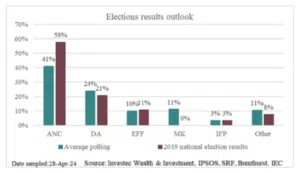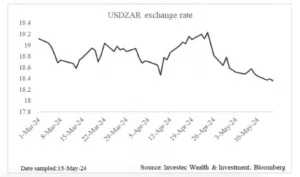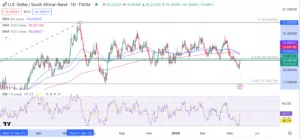-
Best Forex Brokers
Our top-rated Forex brokers
-
Brokers for Beginners
Start trading here
-
Forex Demo Accounts
Learn to trade with no risk
-
ZAR Trading Accounts
Save on conversion fees
-
Lowest Spread Brokers
Raw spreads & low commissions
-
ECN Brokers
Trade with Direct Market Access
-
No-deposit Bonuses
Live trading with no deposit
-
High Leverage Brokers
Extend your buying power
-
Islamic Account Brokers
Best accounts for Muslim traders
-
Market Maker Brokers
Fixed spreads & instant execution
-
All Trading Platforms
Find a platform that works for you
-
TradingView Brokers
The top TradingView brokers
-
MetaTrader4 Brokers
The top MT4 brokers in SA
-
MetaTrader5 Brokers
The top MT5 brokers in SA
-
cTrader Brokers
The top cTrader brokers in SA
-
Forex Trading Apps
Trade on the go from your phone
-
Copy Trading Brokers
Copy professional traders
For the first time in South Africa’s democratic history, the polls show that the ANC will gain less than 50% of the national vote. This scenario implies an unprecedented political landscape, where South Africa will have its first coalition government at a national level.
Similar to 2016, when the ANC lost several major metropolitan municipalities, a coalition government will have a significant impact on South Africa’s policy direction on multiple issues, which will affect the markets. These include land expropriation without compensation, nationalisation of banks and mines, and fiscal and foreign policy, among others.
However, the prospect of a coalition government has raised concerns among market participants, analysts, and citizens. They point to the poor service delivery and political instability that have marred previous coalitions at local government levels. In theory, while coalition governments represent a diverse group of political parties working together for more equitable and effective governance, their track record over the past five years, particularly in the major metros, has been far from successful.
Political scholars have identified several reasons for the failure, including weak leadership, political interference with administration, and an inability to find common ground. More importantly, political parties often struggle to make the shift from being oppositional to compromising and partnering in governance.
According to polling data sampled by Investec Wealth & Investment, Business Tech, in April, the ANC has only 41% support, a 30% drop in overall support compared to 2019. However, Investec analysts acknowledge that the poll data is vulnerable to variability between pollsters’ statements and the quality of the polling and collection methods. Still, anything below 50% will require a coalition government.

How could this affect the rand?
Many would have noticed the rand’s surge in value against the dollar since the end of April, having gone from 19.23/USD to 18.02 on 21 May 2024. Of course, one of the main drivers of this remarkable strengthening is the likelihood of lower interest rates in the US leading to a weaker dollar.

However, many also believe that the ANC’s structural reform programme is having a positive impact. The programme’s mandate is to strengthen institutions, including the South African Revenue Service (SARS) and the Office of the Public Protector. It has also made strides in reforming Eskom, resulting in an easing of load-shedding and improvement in the business environment. Should the ANC get only 40% of the vote, the structural reform will likely continue, but the mechanisms may change. Any threat to the programme could weaken the rand.
The rand has also been buoyed by the reduced possibility of an ANC-EFF coalition, largely due to the emergence of the MK party and expectations that it is likely to form a coalition with the IFP.
Many analysts believe that despite recent positive trends in the currency,they may be short-lived, and any future movements will be closely tied to political developments following next week’s election.
Technical Analysis
Following a rally on the rand since 19 April 2024, the USD/ZAR fell to its lowest levels since August 2023, narrowly missing the R18/USD psychological level on Tuesday, 21 May 2024. Wednesday and Thursday saw a surge in the pair, with the price sitting at R18.39/USD, which corresponds with the Fibonacci 23.6% level of the long-term 2021 – 2023 uptrend.

The crossover of the 50-day EMA (blue) below the the 200-day EMA (pink) on Friday, 17th May 2024 is a strong sign that the downtrend will continue in the medium term. The RSI also seems to confirm this bias, sitting at 46, below the 50% level, which means that the uptrend of the last two days may be short-lived.
Should the short-term uptrend continue, immediate resistance will be experienced at the 18.45 level, which price seems to be respecting. Beyond that, 18.60 is the next barrier, which corresponds with the 50-day EMA.
If price reverses, 18.20 would pose as immediate support, and below that, the low of 2024, at 18.02.
Stay updated
This form has double opt in enabled. You will need to confirm your email address before being added to the list.




























